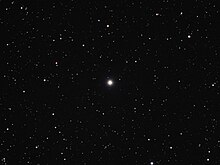Star in the constellation Andromeda
χ Chi Andromedae (χ χ Bayer designation for a star in the northern constellation of Andromeda . It has an apparent visual magnitude of +5.01,[ 2] relatively faint for a naked-eye star. Based upon parallax measurements made during the Gaia mission, Chi Andromedae is located around 264 light-years (81 parsecs ) from Earth.[ 1]
χ Andromedae is a member of 天大將軍 Tiān Dà Jiāng Jūn Heaven's Great General γ Andromedae , φ Persei , 51 Andromedae , 49 Andromedae , θ Andromedae , τ Andromedae , 56 Andromedae , β Trianguli , γ Trianguli and δ Trianguli . Consequently, the Chinese name for χ Andromedae itself is 天大將軍五 Tiān Dà Jiāng Jūn wǔ the Fifth Star of Heaven's Great General .)[ 8]
This is most likely a spectroscopic binary system with an estimated orbital period of 20.8 years and an eccentricity of 0.37. The primary component has a stellar classification of G8 III,[ 6] giant star that has exhausted the supply of hydrogen at its core and evolved away from the main sequence . The outer envelope has expanded to about nine times the radius of the Sun and it is radiating 47[ 5] effective temperature of 5,070 K.[ 5] G-type star .[ 9] projected rotational velocity .[ 5] [ 6]
References
^ a b c d e f Brown, A. G. A. ; et al. (Gaia collaboration) (2021). "Gaia Early Data Release 3: Summary of the contents and survey properties" . Astronomy & Astrophysics 649 : A1. arXiv :2012.01533 Bibcode :2021A&A...649A...1G . doi :10.1051/0004-6361/202039657 S2CID 227254300 . (Erratum: doi :10.1051/0004-6361/202039657e ) . Gaia EDR3 record for this source at VizieR .^ a b c d Anderson, E.; Francis, Ch. (2012), "XHIP: An extended hipparcos compilation", Astronomy Letters , 38 (5): 331, arXiv :1108.4971 Bibcode :2012AstL...38..331A , doi :10.1134/S1063773712050015 , S2CID 119257644 . ^ Argue, A. N. (1966), "UBV photometry of 550 F, G and K type stars", Monthly Notices of the Royal Astronomical Society 133 (4): 475– 493, Bibcode :1966MNRAS.133..475A , doi :10.1093/mnras/133.4.475 ^ van Leeuwen, F. (November 2007), "Validation of the new Hipparcos reduction", Astronomy and Astrophysics , 474 (2): 653– 664, arXiv :0708.1752 Bibcode :2007A&A...474..653V , doi :10.1051/0004-6361:20078357 , S2CID 18759600 . ^ a b c d e f g h i j Massarotti, Alessandro; et al. (January 2008), "Rotational and Radial Velocities for a Sample of 761 HIPPARCOS Giants and the Role of Binarity", The Astronomical Journal , 135 (1): 209– 231, Bibcode :2008AJ....135..209M , doi :10.1088/0004-6256/135/1/209 ^ a b c Griffin, R. F. (June 1998), "Spectroscopic binary orbits from photoelectric radial velocities. Paper 140: Chi Andromedae", The Observatory , 118 : 158– 165, Bibcode :1998Obs...118..158G . ^ "* chi And" . SIMBAD Centre de données astronomiques de Strasbourg . Retrieved 2012-06-25 .^ (in Chinese) AEEA (Activities of Exhibition and Education in Astronomy) 天文教育資訊網 2006 年 7 月 10 日 Archived 2011-07-16 at the Wayback Machine ^ "The Colour of Stars" , Australia Telescope, Outreach and Education , Commonwealth Scientific and Industrial Research Organisation , December 21, 2004, archived from the original on 2012-03-18, retrieved 2012-01-16 .
External links

